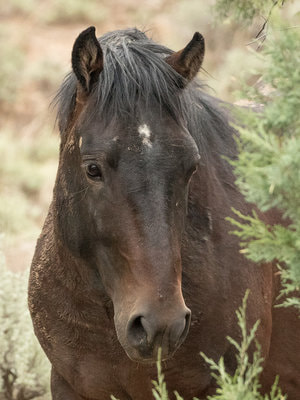THE STORY OF THE MUSTANG

The modern mustang horse is a reintroduced native equine species. The wild mustangs found in the United States today are not the first herds to roam the North American continent. Ancient horses were endemic to North America, and the fossil record showing their evolution indicates that they spread to Eurasia via the Bering land bridge during the Pleistocene epoch. That ancient horse species native to North America, known as Equus, became extinct on the continent roughly ten thousand years ago. Equus disappeared as part of a mass extinction of megafauna that occurred at the end of the last great ice age, where every horse vanished or was wiped out by changing climate, disease, or as a result of early hunters. All of these factors likely contributed to the extinction episode that also included mammoth, wooly rhinoceros, the sabertooth cat, camel, dire wolf, giant ground sloth, and the short-faced bear.
Not until the year 1519 AD, when Spanish explorer Hernán Cortés arrived in Mexico, did horses return to this region, their ancestral home. Early Spanish conquistadors, explorers, and priests brought with them horses from the Iberian peninsula that later escaped or were set free. These horses, now known as mustangs, formed the first herds to be used by the Native Americans. The name mustang comes from the Spanish word “mesteño,” which means “stray” or “wild.” The early mustangs of Spanish origin were later joined by other breeds as Europeans - settlers, trappers, miners, cattlemen, and farmers began to venture to the New World.
In 1971, Congress passed the Wild Free-Roaming Horse and Burro Act, which protected wild horses and burros from being hunted or rounded up for slaughter. The Department of the Interior, through the Bureau of Land Management (BLM) and the Department of Agriculture, through the Forest Service, have the responsibility of administering this law. The “Adopt-A-Horse” program began in 1973 in the Pryor Mountains of Montana as a humane way to distribute excess animals. Today, most of the mustang populations are found in the Western states of Montana, Idaho, Nevada, Wyoming, Utah, Oregon, California, Arizona, Colorado, and New Mexico. The current population in these western states varies but is estimated to be near 70,000 animals, with over 50,000 currently being held in holding facilities across the United States.
The two main mustang herds in New Mexico are the Jicarilla and the Jarito Mesa wild horse territories, both in the Carson National Forest. These two herds alone were counted at over 400 horses in 2019. Both the Jicarilla and the Jarito Mesa herds carry the DNA of the Spanish horses known as Venezuelan Crillolo, Galiceño , Garrano, Andalusian, Norkier and the Mangalarga Marchador among others.
Not until the year 1519 AD, when Spanish explorer Hernán Cortés arrived in Mexico, did horses return to this region, their ancestral home. Early Spanish conquistadors, explorers, and priests brought with them horses from the Iberian peninsula that later escaped or were set free. These horses, now known as mustangs, formed the first herds to be used by the Native Americans. The name mustang comes from the Spanish word “mesteño,” which means “stray” or “wild.” The early mustangs of Spanish origin were later joined by other breeds as Europeans - settlers, trappers, miners, cattlemen, and farmers began to venture to the New World.
In 1971, Congress passed the Wild Free-Roaming Horse and Burro Act, which protected wild horses and burros from being hunted or rounded up for slaughter. The Department of the Interior, through the Bureau of Land Management (BLM) and the Department of Agriculture, through the Forest Service, have the responsibility of administering this law. The “Adopt-A-Horse” program began in 1973 in the Pryor Mountains of Montana as a humane way to distribute excess animals. Today, most of the mustang populations are found in the Western states of Montana, Idaho, Nevada, Wyoming, Utah, Oregon, California, Arizona, Colorado, and New Mexico. The current population in these western states varies but is estimated to be near 70,000 animals, with over 50,000 currently being held in holding facilities across the United States.
The two main mustang herds in New Mexico are the Jicarilla and the Jarito Mesa wild horse territories, both in the Carson National Forest. These two herds alone were counted at over 400 horses in 2019. Both the Jicarilla and the Jarito Mesa herds carry the DNA of the Spanish horses known as Venezuelan Crillolo, Galiceño , Garrano, Andalusian, Norkier and the Mangalarga Marchador among others.

